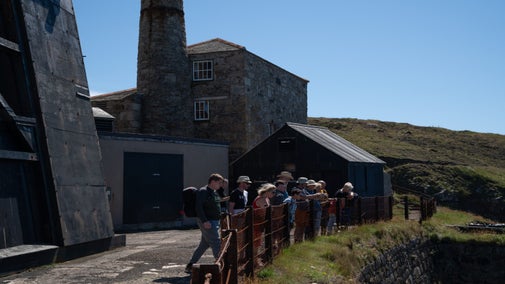
Book your visit
Please note you need to book tickets to Levant Mine and Beam Engine. You can book for today up to an hour before the start of a tour. Every Thursday time slots will be available for the next 14 days.

Levant Mine and Beam Engine sits on the rugged cliffs of the ‘Tin Coast’, part of the Cornish Heritage World Mining Site. See the steam-powered beam engine, built in 1840 and the only one of its kind. Explore the wider site including the count house ruins, miner’s ‘dry’ area and towering chimney stacks. Observe the diverse natural habitats, home to local wildlife including the rare Cornish chough.
Pre-book your guided tour to start your visit to the World Heritage Site of Levant. Walk along Maggies Lane footpath from Geevor Mine, following in the footsteps of those who worked and lived here. The Levant Mine and Beam Engine Tour lasts for approximately one to one and half hours and incorporates all of the site including the man engine tunnel, skip shaft, zawn and beam engine. Levant also offers family tours during school holidays which are interactive and focused torwards family groups. These last an hour.
At the heart of the site is the 1840s beam engine, powered by steam – the only one of its kind in its original engine house. See the moving engine, which was originally used to bring the ore up to the surface, in action.
The skip shaft sits close to the cliff edge and is over 500m (1650ft) deep. It was initially sunk to bring ore to the surface in skips using the steam engine. In 1970 the electric winder was installed and used to winch the man cage.

Step inside the Winder House built by Geevor mine in the late 1960s. It houses the electric winder that winched engineers in a man cage up and down skip shaft.
Prior to the man cage, the skip shaft was used for skips containing rocks and ore being pulled to the surface by the steam engine: the 19th-century forerunner of the electric winder.
Walk through the short tunnel that leads to the side of the man engine shaft. Look out for the alcoves at each side where miners would leave their helmets and candles.
Thirty-one miners sadly lost their lives in the shaft when the man engine failed in 1919. It was the second worst mining disaster in Cornish history.
Walk around the remains of the Compressor House and the Count House. The Count House is one of the site's most important buildings, housing the accountant who handed out wages for workers. Dinners for important shareholders were also hosted here. The granite and brick top stacks serve as a reminder that this coastal site was once an industrial landscape, with all the noise and smoke that goes with it.
See the remains of the miner’s dry where the miners would change prior to starting work and going underground. At the end of each shift they would bathe here before changing and going home. You can still see the baths in the concrete foundations.
A little further up the hill is the site of Higher Bal which was acquired by the mine in the late Victorian era. By exploring the wider site you can see how busy the area would have been in its heyday. From this vantage point many mine remains and chimney stacks can be seen along the coast in both directions.

The habitat for wildlife here is diverse and ranges from the steep cliffs at the sea’s edge to heathland and a patchwork of small granite-walled fields. During spring and summer the clifftops are transformed by the colours of flowering sea campion, thrift, thyme, scabious and centaury.
The plants form part of the habitats loved by butterflies and moths. Six-spot burnet moths are a regular sighting here – their red spots can easily be seen against their darker wings. The mine waste also provides a micro habitat for specialised plants and lichen.
The Cornish chough is the symbolic bird of Cornwall. This rare and beautiful bird left the area over 50 years ago but conservation of their habitats is now seeing their return. Look out for their black feathers and distinctive curved red beaks.
Peregrine falcons and kestrels can often be seen flying near the old engine houses. Take a walk up to Levant Fields to see a wide variety of birds including linnets, rock pipits and buzzards.
Many artists come to St Just and the surrounding coast and countryside for inspiration. This changing landscape provides ample opportunity for you to complete drawings and artwork of the landscape, nature and buildings. Why not bring your sketchbook and have a go yourself?
For more mining sites to visit take a short walk from Levant to Botallack, where you can see the iconic Crowns Engine Houses clinging to the foot of the cliffs.

Please note you need to book tickets to Levant Mine and Beam Engine. You can book for today up to an hour before the start of a tour. Every Thursday time slots will be available for the next 14 days.
Discover more about mining at Levant Mine and Beam Engine. Find out the key dates of interest and the kind of work that was carried out here.

Find out more about this Cornish tin mine on the Tin Coast near Levant. With parking and facilities it’s a great place to visit in combination with Levant.

Levant Mine and Beam Engine offers a variety of tours throughout the year. Access to Levant is by tour only so booking is advised.
